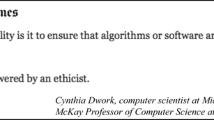Conclusion
The government has accepted the Nolan recommendations ‘in principle’ and the Whistleblower Protection Bill has all-party support. There seems to be agreement that ‘a new culture of openness and responsibility’ is needed and NHS staff should be among the first to benefit, with useful repercussions for the patients. The pressures to infringe the latter's privacy are not, however, likely to grow weaker, and have so far received little public attention: they should provoke a search for new data-processing methods which do not merely serve market management but are fully intelligible to patients, allow efficient retrieval for treatment purposes and are consistent with the preservation of patient confidentiality.
Similar content being viewed by others
References
The Times (1995). 21 June.
Delany, L. (1994). Health care law.Health Care Analysis 2(2), 140–146.
Murray, I. (1995). Disabled pensioners win community care battle.The Times, 17 June.
Delany, L. (1993). Health care law.Health Care Analysis 1(2), 170–178.
References
Conditional Fees Order 1995 andConditional Fees Regulations 1995.
Lord Mackay. (1995). Reducing risks for clients.The Gazette 92/26, 5 July.
Zander, M. (1995). Well anyway, conditional fees should be a bonanza for lawyers.New Law Journal 920.
References
Kennedy, I. (1994). Between ourselves.Journal of Medical Ethics 20, 69–70, 100.
Department of Health. (1994).Confidentiality, Use and Disclosure of Personal Health Information. Draft Guidance, Department of Health, London.
Department of Health (1994).Confidentiality, Use and Disclosure of Personal Health Information. Draft Guidance, para. 4.9, Department of Health, London.
See, for example, the case ofX v Y [1988] 2 All ER 648.
See, for example, the case ofW. v Egdell [1990] 1 All ER 835.
Data Protection Registrar. (1994).Tenth Report of the Data Protection Registrar, HMSO, London.
Audit Commission. (1994).Setting the Records Straight: A Study of Hospital Medical Records, HMSO, London.
Craft, N. (1994). Secrecy in the NHS.British Medical Journal 309, 1640–1643.
Smith, R. (1994). An unfree NHS and medical press in an unfree society.British Medical Journal 309, 1644–1645.
Enacted by the National Health Service and Community care Act 1990.
Department of Health National Health Service Management Executive. (1993).Guidance for Staff on Relations with the Public and the Media, Executive Letter (93)51, Department of Health, Leeds.
Rose, N. (1995). Whistleblowing: time for a change?New Law Journal, 113–115.
The Lord Nolan. (1995).First Report of the Committee on Standards in Public Life, Cm 2850-I, HMSO, London.
House of Commons. (28 June 1995).Official Report, Cols 911–912.
Rights and permissions
About this article
Cite this article
Delany, L. Health Care Law. Health Care Anal 3, 324–331 (1995). https://doi.org/10.1007/BF02197080
Issue Date:
DOI: https://doi.org/10.1007/BF02197080




